 Step 1: Submit a Show of Interest (SOI)
Step 1: Submit a Show of Interest (SOI)New resources that want to participate in the Forward Capacity Market (FCM) must submit documentation demonstrating the resource’s ability to operate at a specific megawatt value for the relevant capacity commitment period (CCP). ISO New England evaluates this information to confirm capacity:
The first step in qualifying a new resource is submitting a new capacity show of interest form with project information via the Forward Capacity Tracking System (FCTS). The following video will walk you through how to submit a show of interest (SOI):
Regarding substitution auction participation: New renewable, clean, zero carbon, or alternative resources that receive a government-regulated rate, charge, or other regulated cost recovery mechanism outside of ISO markets (sponsored policy resources) can elect to participate in a substitution auction. Be aware that some of the deadlines overlap with those for the primary auction. See the FCM Substitution Auction Overview and Timeline and Supply Participation in the FCM Substitution Auction for details.
A new generator must have a valid and active interconnection request in place by the close of the SOI submission window with either ISO New England or the local transmission/distribution company, depending on interconnecting jurisdiction. For details, see the following sections of the Open Access Transmission Tariff (OATT): Schedule 22, Large Generator Interconnection Procedures; Schedule 23, Small Generator Interconnection Procedures; and Schedule 25, Elective Transmission Upgrade Interconnection Procedures.
Please consult the flowchart provided in the ISO New England Interconnection Process Guide for more information on determining which interconnection process your new generator must follow.
Projects whose interconnection falls outside the ISO’s jurisdiction must provide a copy of the interconnection application submitted to the distribution company specifying the point of interconnection, substation name, distribution feeder number, interconnecting distribution company name, and the specific project tracking number used by the distribution company during the interconnection process. Project sponsors must also self-certify that they hold full and direct site control and title to the capacity rights. Please consult the “New Generation and Imports Show of Interest” training for more information.
Generators that submitted an SOI in the last qualification cycle but withdrew, were denied, didn’t clear, or only partially cleared can reuse the information in that SOI. See the carryover instructions.
Note that there are two types of new generating resources:
Typically, resources must be made up of one single generation type. However, inverter-based intermittent generation (such as solar or wind) that is co-located within the same facility as an energy storage component may be able to qualify as either a non-intermittent or intermittent resource. Please consult the Market Participation Options for Combined Intermittent/Electric Storage Facilities training available on the Training Materials webpage for more information.
An SOI can be submitted for a new generator that hasn’t previously cleared in a Forward Capacity Auction (FCA).
Certain kinds of existing generation may also seek qualification as a new resource:
*For the specific amount per kilowatt, see the cost threshold adjustment parameters for each FCA available on the FCM Parameters section of the FCM webpage.
FCA qualification price thresholds are adjusted annually using the most recent Handy-Whitman Index of Public Utility Construction Costs. These thresholds apply to existing generation seeking qualification as a new resource based on:
For details, see Market Rule 1, Sections III.13.1.1.1.2 to III.13.1.1.1.4.
The Handy-Whitman Index is derived from cost trends in public utility construction. The ISO uses the index’s data on “Total Other Production Plant” costs (construction and equipment) in the North Atlantic region.
As the first year of the FCM, 2008 serves as the benchmark year. The cost-threshold adjustment parameters used in FCM qualification are as follows:
The cost-threshold adjustment formula: benchmark year costs × (variable index value ÷ base index value).
For example, for the FCA conducted for CCP 2026–2027 (FCA 17), thresholds are calculated as follows:
These adjusted qualification thresholds for each FCA are available on the FCM Parameters section of the FCM webpage.
The Handy-Whitman Index publisher, Whitman, Requardt & Associates, LLP, has granted the ISO permission to distribute data.
The SOI is due approximately nine months before the FCA. Check the dates for the SOI submission window in the appropriate FCA calendar. (Learn how to access the auction calendars.)
When the SOI window is open, project sponsors can enter an SOI application via the Forward Capacity Tracking System (FCTS). A digital certificate is required to access FCTS. Your security administrator for the ISO’s Customer and Assets Management System (CAMS) can provide this.
To submit the SOI:
See the sample show of interest application form. The form for generators requests information including, but not limited to, the following:
In some cases, a new resource can reuse a previously submitted show of interest (SOI).
You can reuse an SOI for a project using the carryover functionality in the Forward Capacity Tracking System (FCTS) if the following are true:
The project name and ID from the previous CCP will be retained when using the carryover functionality in the FCTS. Updates to a carried-over SOI are permitted as long the SOI window is still open.
The carryover functionality in the FCTS can be used during the SOI submittal window. (Learn how to access the auction calendars.)
For screenshots related to the use of the carryover functionality in the FCTS, see the “New Generation and Imports Show of Interest (SOI)” or “Demand Capacity Resources Show of Interest (SOI)” training. Both are available on the Training Materials webpage. The following video will walk you through how to submit an SOI using the FCTS carryover functionality:
When using the FCTS carryover functionality to submit an SOI, carefully review the resulting SOI form to ensure it is up to date. Failure to meet any new submission requirements or properly update any previously submitted data may result in rejection of your proposal.
With each show of interest (SOI), the project sponsor must submit a refundable qualification process cost reimbursement deposit (QPCRD). The deposit is used for costs the ISO and its consultants incur, including affected transmission owners’ documented and reasonably incurred costs associated with the qualification process.
Use the appropriate form available on the Financial Assurance and Credit page to set up payment for the QPCRD.
For the amount required, see the table in Market Rule 1, Section III.13.1.9.3, Qualification Process Cost Reimbursement Deposit.
The QPCRD is billed as a line item on the Non-Hourly invoice issued by the ISO typically in May after the close of the SOI window. If payment is not received by the ISO by the invoice due date, the project will be withdrawn.
The remaining balance of the QPCRD is returned for projects meeting eligibility criteria (noted in the table below) during specific intervals in a year:
Return Timeframe |
Projects eligible for Return |
|---|---|
1st QPCRD Returns List—after the close of SOI for the CCP (CCPn) |
|
2nd QPCRD Returns List—after FCA qualified capacity is published for CCPn |
|
The QPCRD return check and the annual statements will be addressed to the project credit/financial contact listed within FCTS; this contact for each project should always be kept up to date.
The new capacity qualification package (NCQP) is the next major submittal after the show of interest (SOI) submittal.
The NCQP is a set of data, forms, applicable supporting documents, and elections that collectively demonstrate the viability of a project.
For new generators, the NCQP consists of four major components:
Most project sponsors are expected to complete more than one section of the package depending on the resource type.
Intermittent generation resources seeking qualification need to provide their requested summer and winter qualified capacity and additional information to support their requested summer and winter qualified capacity as part of their NCQP.
This additional information should contain site-specific data, as well as all calculations deriving the claimed capacity using resource data, equipment energy conversion efficiencies, etc. This information will be used to confirm the requested summer and winter qualified capacity.
If the intermittent resource seeking qualification contains an energy storage component, submission of data regarding the energy storage system is required as part of the project’s associated show of interest. Data on the project’s intermittent component must be provided as part of the NCQP, as well as requested summer and winter megawatt values that are only reflective of the intermittent (e.g., solar or wind) portion of the co-located facility.
As part of their NCQPs, commercial intermittent resources will need to identify their registered asset. The asset’s historical seasonal claimed capability (SCC) will be used to confirm the requested summer and winter qualified capacity.
Detailed data submittal guidelines for each type of intermittent resource are available on the FCM page.
The NCQP must be submitted in June four years before the beginning of the CCP. The submission window opens on the deadline for existing capacity qualification. For the specific window dates, learn how to access the auction calendars.
The NCQP must be submitted through the Forward Capacity Tracking System (FCTS). The ISO will not accept any submittal via email. The following video will walk you through how to submit an NCQP:
The project sponsor must complete each component of the NCQP as applicable. Once the documentation is submitted, the ISO may consult with the project sponsor to seek clarification, gather additional necessary information, or address questions that arise from the material submitted.
The information requested in the NCQP depends on your resource type. This information may include, but is not limited to, the following:
New capacity resources requesting to submit offers below the relevant ORTP must also submit with their NCQP sufficient documentation and information to permit the Internal Market Monitor to perform its review (details below). Recommended documents include, but are not limited to, the following:
Cost information is required for all new generating capacity resources seeking to participate in the FCA with the following project types:
Cost data associated with the project must contain sufficient detail to allow the ISO to determine that the relevant cost threshold will be met. Environmental compliance projects must include a detailed description of the specific regulations the project is seeking to comply with and the permits it must obtain.
The Internal Market Monitor (IMM) is responsible for ensuring the competitiveness of the FCM and other ISO New England markets through the following activities:
In the FCM, mitigation is performed by these actions:
ORTPs are the default values applied to capacity seeking to participate in the upcoming auction, which the IMM sets at the lower end of the competitive range for a particular technology type.
An ORTP is assigned to a new capacity resource during the show of interest process. During the FCA, the ISO removes the resource’s offered megawatts once the threshold price has been reached. However, a market participant has the option of requesting a lower offer floor price by submitting documentation demonstrating why the new capacity resource requires less compensation from the FCM than resources of a similar category. (Recommended documentation is noted above.)
The IMM will review market participant requests for an offer floor price below the ORTP and all associated documentation to determine if the requested value is a more accurate representation of the resource’s costs. The IMM may accept the requested lower value. However, if the IMM determines that the submission does not contain adequate information to support a price lower than the ORTP, the IMM will mitigate the offer up, capping the value at the ORTP. If the IMM determines that the requested value is not reflective of the resource’s true costs, the IMM will mitigate the offer to a price reflective of market conditions.
The qualification determination notification (QDN) of the resource provides the final offer floor price after IMM review and any mitigation. QDNs are accessible in the FCTS along with an explanation for why a resource was mitigated, if applicable.
As part of the new resource qualification process, a new generating resource will be subject to the initial interconnection analyses to ensure that (1) the new generating resource does not cause overloads that cannot be fixed in time for the capacity commitment period (CCP) and that (2) its capacity is deliverable within the load zone into which it will be interconnecting.
Existing resources seeking to qualify additional capacity will be studied at a capacity value above their current capacity network resource capability (CNRC).
Two reliability assessments are performed as part of the new generating resource qualification process:
The initial interconnection analysis is performed following these rules:
The purpose of the analysis is to assess:
The assessment includes steady-state power flow analysis, short-circuit analysis and other analyses depending on project type. Results from studies completed pursuant to ISO-NE and/or local interconnection procedures for large and small generators and elective transmission upgrades are used whenever available.
This test helps the ISO ensure that the new generating capacity resource under study does not cause overloads that cannot be fixed in time for the CCP. For example, in the diagram below:
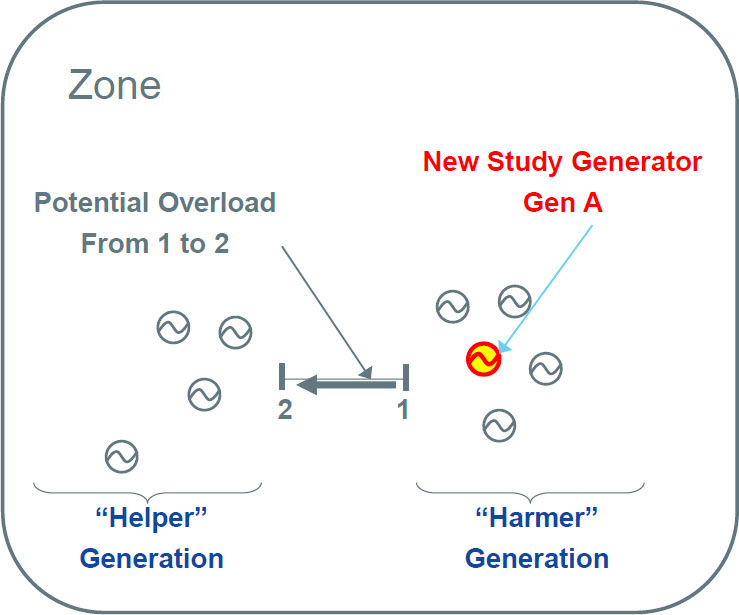
The overlapping impact analysis helps the ISO determine if a proposed new capacity resource or an elective transmission upgrade (ETU) provides incremental capacity to the system by doing the following to meet the CCIS:
The overlapping impact analysis is performed as a group study. All generating capacity resource projects in the ISO’s Interconnection Request Queue or in a state interconnection process seeking capacity network resource or import interconnection service are included on the basis of their queue position or the date that they receive I.3.9 approval, respectively.
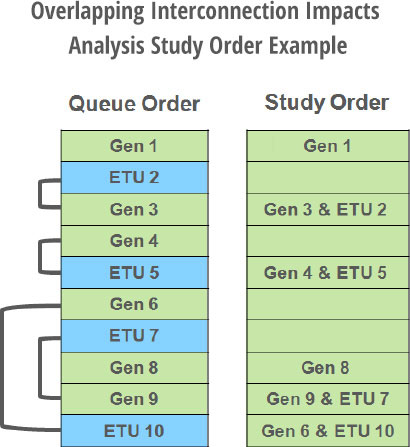
The generator redispatch criteria are as follows:
The transfer-level criteria are as follows:
General test conditions:
The overlapping impact analysis will indentify any required qualification transmission upgrades (QTUs) for the study resource. These are transmission upgrades that the project sponsor will be responsible for addressing to make the resource's capacity deliverable to the relevant load zone.
Reference ISO Planning Procedure No. 10, Planning Procedure to Support the Forward Capacity Market (PP 10) for additional information on QTU identification.
Conditional qualification provisions apply when a resource may not qualify as a result of overlapping interconnection impacts with another resource. In these cases, Interconnection Request Queue order is used to establish priority for a conditional qualification scenario.
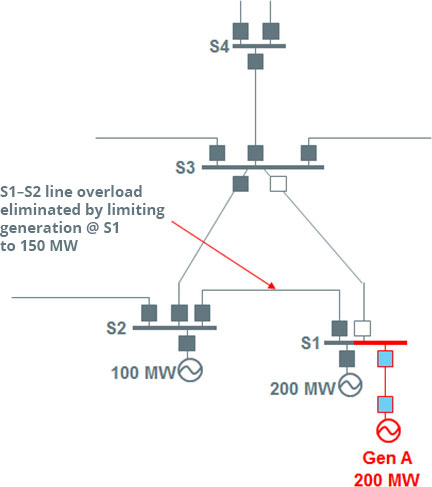
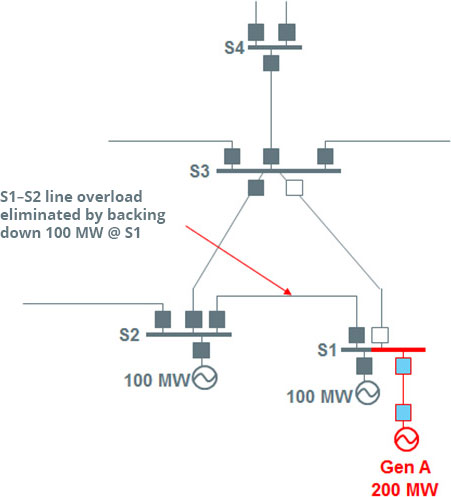
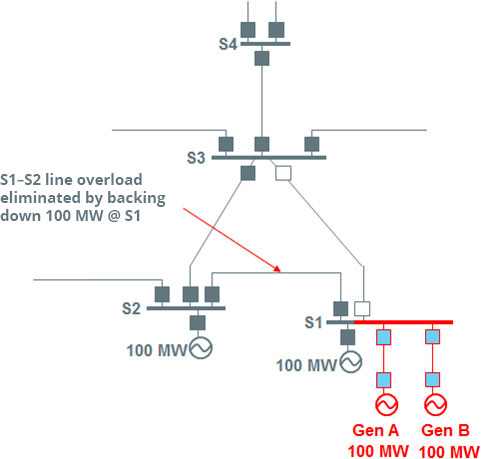
Generator-based upgrades identified through these assessments will be listed in the qualification determination notification (QDN) of the resource, accessible in the Forward Capacity Tracking System (FCTS).
If a new resource clears in the FCA, the overlapping impact analysis will be performed again, and the final list of required upgrades will become part of the critical path schedule (CPS) for the project. The progress of these upgrades, along with all other CPS milestones, will be monitored.
Reference ISO Planning Procedure No. 10, Planning Procedure to Support the Forward Capacity Market (PP 10) for additional information on the methodology for restudying overlapping impacts.
No later than 150 days before the Forward Capacity Auction, project sponsors must inform the ISO of any changes to their projects that may reduce their capacity.
However, material modifications may not be made. If material modifications are necessary, the project will be withdrawn from FCA qualification.
Please contact ISO System Planning by creating an AskISO case to discuss all potential changes.
To find out whether your resource is accepted for participation in the Forward Capacity Auction, check your qualification determination notification. Project sponsors can access these notifications through the Forward Capacity Tracking System (FCTS) no later than 127 days before the Forward Capacity Auction.
If your resource was not accepted, the notification will explain why.
If your resource was accepted, the notification will include the following information:
Project sponsors may elect to have the qualified capacity of their resource participate in primary auctions as a renewable technology resource (RTR). A designated amount of megawatts from RTRs are exempt from the minimum offer floor price requirement in each capacity commitment period (CCP). RTR treatment is only applicable for the Forward Capacity Auctions (FCAs) 17 and 18 for CCPs 2026–2027 and 2027–2028, respectively.
To participate as an RTR, the resource must elect RTR treatment and qualify as a sponsored policy resource. A sponsored policy resource is a new capacity resource that meets the following criteria:
The FCA qualified capacity of a resource associated with an RTR election is subject to proration when the FCA qualified capacity of all resources associated with an RTR election exceeds the available capacity for RTR treatment assigned to the relevant CCP. In such cases, only the RTR prorated FCA qualified capacity participates in the primary auction. For example, if
RTR proration does not apply to the qualified capacity of supply offers participating in the Substitution Auction.
The RTR election must be made through the Forward Capacity Tracking System under the New Qualification Elections tab. There, the project sponsor shall submit the RTR election form and supporting documentation demonstrating that the resource meets each of the eligibility criteria noted above. Required information specified in the RTR election form includes:
The election form can be found in FCM Materials under FCM Forms and Guides.
In certain instances, the ISO will automatically match an existing resource’s newly qualified additional megawatts with existing seasonal capacity at the same resource. Participants cannot opt out of automatic matching.
Automatic matching applies to these projects:
The amount of capacity eligible to be automatically matched will be limited to the excess existing megawatts in the offsetting season (summer or winter) at the same resource. Any remaining seasonal incremental capacity will need to form a composite offer to participate in the FCA.
The automatic matching process will occur before the opening of the composite offer window. (Learn how to access the auction calendars.)
An existing capacity resource submits a request to increase its capacity by 20 MW in the summer and 0 MW in the winter, and the increase is qualified as an incremental upgrade. The newly qualified summer megawatts are automatically matched to the excess existing winter capacity, and both the incremental capacity and the matched existing capacity.
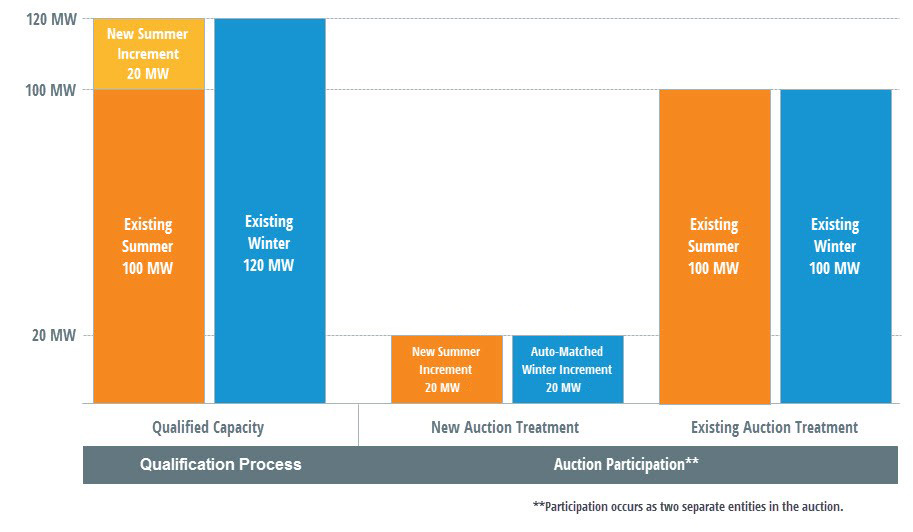
An existing capacity resource submits a significant increase in capacity for 20 MW of summer capacity and 0 MW of winter capacity. Both the significant increase in capacity and the base resource are qualified as existing capacity. The qualified summer significant increase megawatts are automatically matched to the excess existing winter capacity at the same resource.
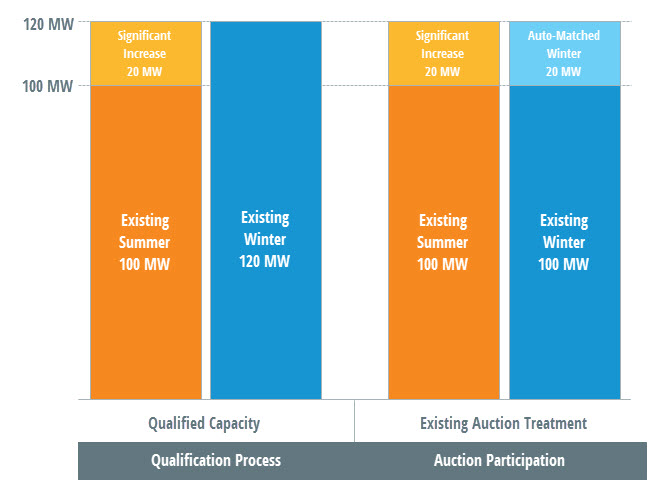
An existing capacity resource submits a show of interest to increase its capacity by 30 MW in the summer and 0 MW in the winter. The resource is qualified as an incremental upgrade. Only 20 MW of summer incremental increase are automatically matched to the excess existing winter capacity at the associated FCA clearing price. A composite offer will need to be submitted for the resource to bring the excess remaining capacity (10 MW) to the auction.
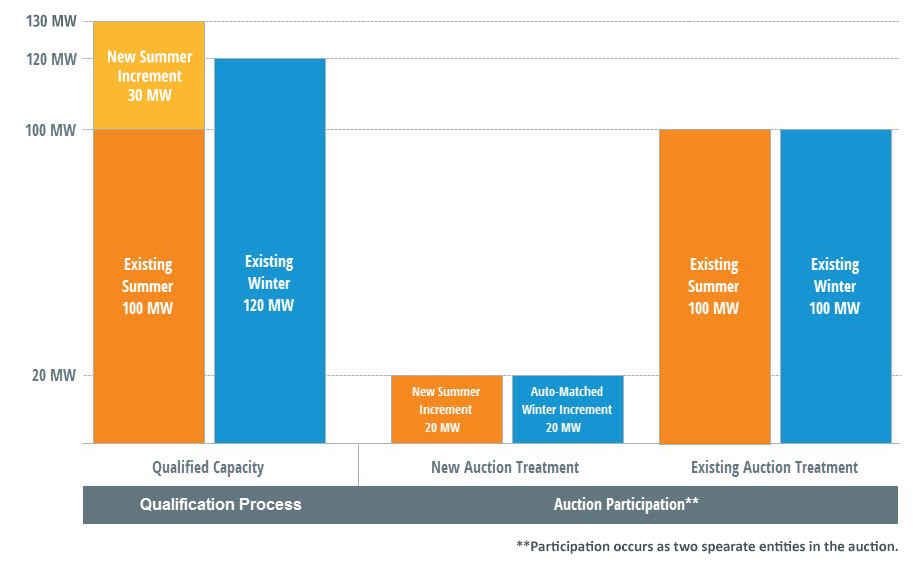
A composite offer allows capacity resources that have each received a qualified capacity value to participate together to maximize their combined offer in a Forward Capacity Auction.
Composite offers can be submitted during the composite offer window for the desired FCA. (Learn how to access the auction calendars.) Composite offers can be modified or withdrawn in the Forward Capacity Tracking System (FCTS) until the composite offer deadline.
Throughout the composite offer submittal process, the FCTS will enforce various validation rules on partner eligibility:
Composite offers are submitted into the Forward Capacity Tracking System by selecting a specific new or existing resource. For new resources, select the New Qualification tab, then the Composite Offer tab:

For existing resources, select the Existing Qualification tab, then the Composite Offer tab:

The project sponsors for the summer and winter resources must cooperate to complete the following steps by the deadline. Composite offers submitted after the deadline will not be considered in the FCA. Please note:
FCTS Actions Required by Each Partner |
||
|---|---|---|
Summer resource |
Winter resource |
|
Initiate the composite offer in the FCTS. The Composite Offer Status will display as “Pending.” Ask your winter partner to act. |
1 |
|
|
2 |
Designate the winter resource to the composite offer. Status remains “Pending.” Ask your summer partner to act. |
Submit the composite offer. Status displays “Confirmed.” Ask your winter partner to act. |
3 |
|
Verify submission:Composite Offer Status should display “Confirmed” and both participating resources should appear under Winter Resource Information (MW). If they don’t, contact Participant Support. |
4 |
Verify submission: Composite Offer Status should display “Confirmed” under the Composite Offer Winter Resource Details window. If it doesn’t, Step 3 has not been completed. Ask your summer partner to act. |
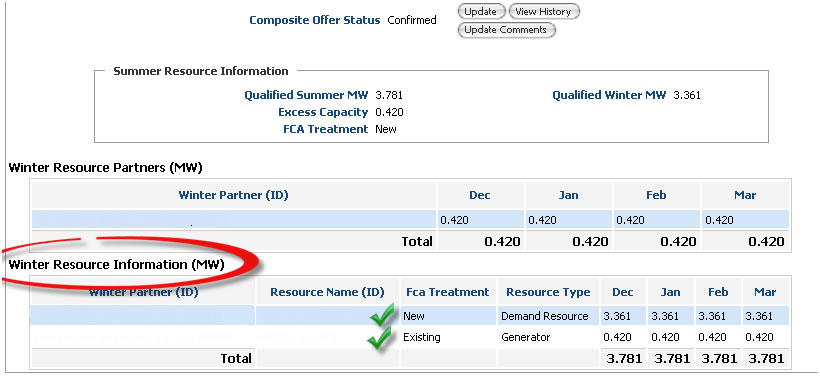
Only the summer resource partner in a composite offer should bid in an FCA. Both resources do not need to bid individually.
Each resource will be paid individually.
The Forward Capacity Auction Qualified Capacity (FCA QC) is the amount of megawatts, as determined in the qualification process, that a resource is capable of providing in the summer and winter during a specific capacity commitment period. Resources must pay financial assurance based on the FCA QC.
Your FCA QC is available in the Forward Capacity Tracking System (FCTS).
Learn about qualified capacity for reconfiguration auctions and CSO bilateral periods.
A market participant may choose to cover its FCM obligations by using resources it owns or has contracted with. The contract or agreement usually takes place outside of the ISO marketplace. Designating capacity from a resource as self-supply allows a load-serving entity (LSE) to satisfy its capacity load obligation using resources owned or under contractual obligation of the LSE.
For all resources—new or existing—the lead market participant must designate a resource as self‐supplied no later than the date new resources are required to post their financial assurance for the same capacity commitment period. (Learn how to access the auction calendars.)
All self-supply designations are done through the Forward Capacity Tracking System (FCTS). The designation window opens after the ISO posts Market Information Server (MIS) reports on each LSE’s projected share of the Installed Capacity Requirement.
The steps to submit a self-supply designation, which must be completed by the self-supply submittal deadline, are as follows:
Throughout the designation process, the FCTS will enforce various validation rules on eligibility:
New capacity resources are responsible for posting financial assurance on their FCA qualified capacity.
Use the appropriate form available on the Financial Assurance and Credit page to set up financial assurance payments.
Check the due date in the auction calendars. (Learn how to access the auction calendars.)
A new capacity resource that has been qualified to participate in a Forward Capacity Auction (FCA) for a given capacity commitment period (CCP) may elect critical path schedule (CPS) monitoring. CPS monitoring ensures the following for the resource:
This CPS monitoring election is an annual election made by new capacity resources before the FCA. Check the due date in the auction calendars. (Learn how to access the auction calendars.)
Once made, this election is irrevocable. A change in the CPS milestones may result in a change in eligibility to participate in earlier CCPs’ reconfiguration auctions.
The CPS monitoring election must be made through the Forward Capacity Tracking System (FCTS) under the New Qualification Elections tab during the CPS monitoring election window. As you make the election, you will be required to provide an update to the CPS submitted as part of the new capacity qualification package.
Forward Capacity Market participants should become familiar with the ISO’s market settlement and billing processes. See the FCM Settlements and Billing page for helpful resources.